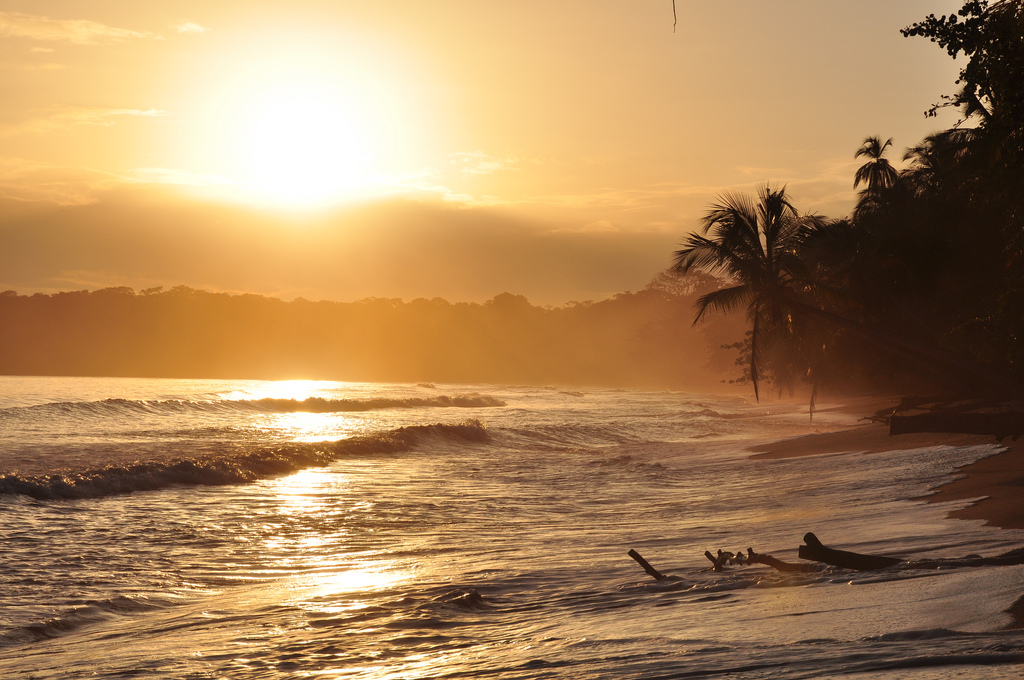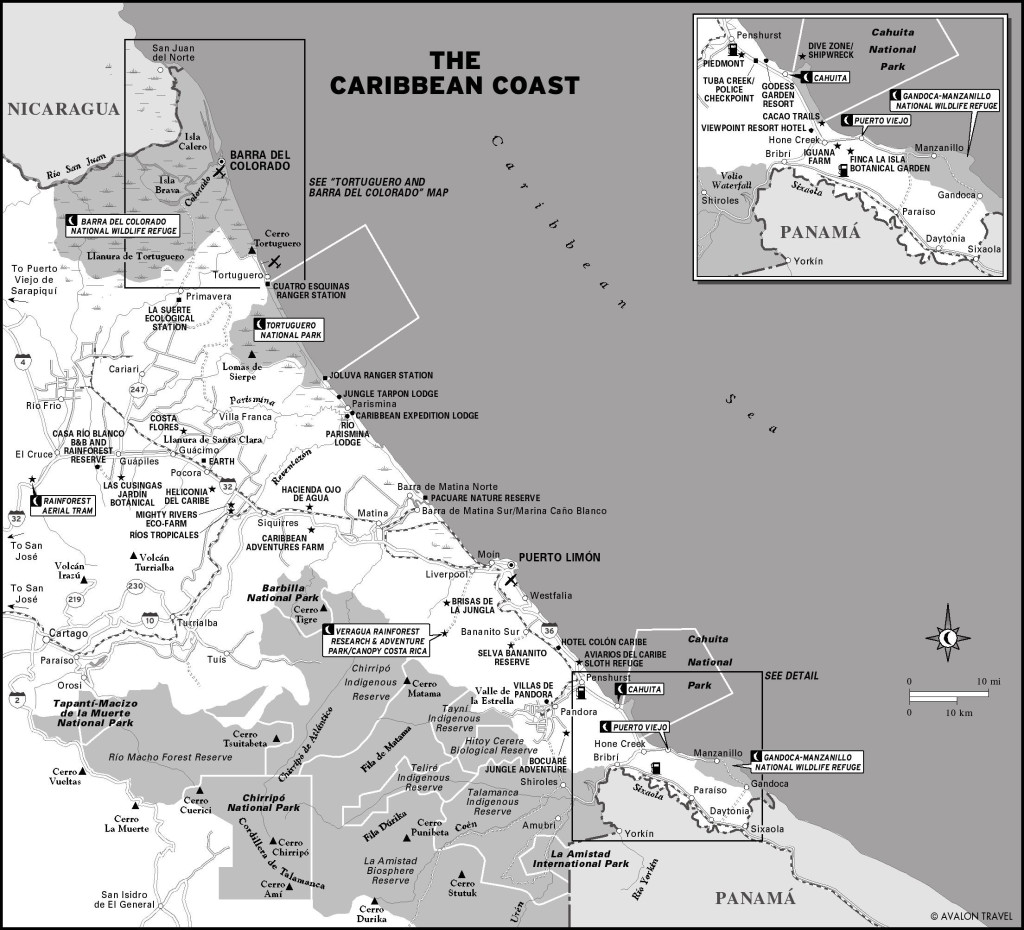
A beautiful golden sunrise in Cahuita, Costa Rica. Photo © Armando Maynez, licensed Creative Commons Attribution.
Costa Rica’s Caribbean coast extends some 200 kilometers (120 miles) from Nicaragua to Panamá. The zone—wholly within Limón Province—is divided into two distinct regions.North of Puerto Limón, the port city midway down the coast, is a long, straight coastal strip backed by a broad alluvial plain cut through by the Tortuguero Canals, an inland waterway that parallels the coast all the way to the Nicaraguan border. Crocodiles, caimans, monkeys, sloths, and exotic birds can be seen from the tour boats that carry passengers through the jungle-lined canals and freshwater lagoons culminating in Parque Nacional Tortuguero and Refugio Nacional de Vida Silvestre Barra del Colorado, a national wildlife refuge. A few roads penetrate to the northern frontier far inland of the coast, but they are often impassable except for brief periods in the dry season. For locals, motorized canoes (cayucos or canoas) and water taxis are the main means of getting about the swampy waterways.
The coast is sparsely settled, with tiny villages spaced far apart. Except for the coastal town of Puerto Limón, what few villages lie along the coast are ramshackle and beaten by tropical storms, though given a boost by booming tourism. South of Puerto Limón is the Talamanca coast, a narrow coastal plain broken by occasional headlands and coral reefs and backed by the looming Cordillera Talamanca. A succession of sandy shores leads the eye toward Panamá. The zone is popular with surfers.The coast is sparsely settled, with tiny villages spaced far apart. Except for the coastal town of Puerto Limón, what few villages lie along the coast are ramshackle and beaten by tropical storms, though given a boost by booming tourism. Life along the Caribbean coast of Costa Rica is fundamentally different than in the rest of the country. Life is lived at an easy pace. It may take you a few days to get in the groove. Don’t expect things to happen at the snap of your fingers.
The black costeños (coast dwellers), who form approximately one-third of Limón Province’s population of 250,000, have little in common with the sponyamon—the “Spaniard man,” or highland mestizo, who represents the conservative Latin American culture. More than anywhere else in Costa Rica, the peoples of the Caribbean coast reflect a mingling of races and cultures. There are Creoles of mixed African and European descent; black Caribs, whose ancestors were African and Caribbean Indian; mestizos, of mixed Spanish and Amerindian blood; more Chinese than one might expect; and, living in the foothills of the Talamancas, approximately 5,000 Bribrí and Cabecar indigenous people.

The Caribbean Coast
The early settlers of the coast were British pirates, smugglers, log-cutters, and their slaves, who brought their own Caribbean dialects with words that are still used today. During the late 19th century, increasing numbers of English-speaking Afro-Caribbean families—predominantly from Jamaica— came to build and work the Atlantic Railroad and banana plantations, eventually settling and infusing the local dialect with the lilting parochial patois phrases familiar to travelers in the West Indies. Afro-Caribbean influences are also notable in the regional cuisine and in the Rastafarians one meets in Cahuita and Puerto Viejo. Some of the young black males here appear sullen and lackadaisical, even antagonistic; some seem to harbor a resentment of white visitors. But most locals have hearts of gold, and there’s a strong, mutually supportive community that travelers may not easily see. (Paula Palmer’s What Happen: A Folk History of Costa Rica’s Talamanca Coast and Wa’apin Man provide insight into the traditional Creole culture of the area.)The Caribbean coast is generally hot and exceedingly wet, averaging 300-500 centimeters (120-200 inches) of rain annually. Except for September and October, the region has no real dry season and endures a “wet season” in which the rainfall can exceed 100 centimeters (39 inches) per month. Rains peak May-August and again in December and January, when sudden storms blow in, bowing down the coconut palms, deluging the Talamancas, and causing frequent flooding and closures of the road south of Limón.
Despite new opportunities from the tourism boom, or perhaps because of it, the region has witnessed a burgeoning drug trade, and in recent years Limón has been consumed by gang wars. The southern Caribbean has also developed a reputation for crime against tourists. Drugs are prevalent, and in Cahuita and Puerto Viejo visitors may be pestered by young males trying to sell them drugs. Hoteliers in the region claim that the bad reputation is all a sad misrepresentation, but during my most recent visits, things seemed to have gotten worse, including several violent attacks and murders. In March 2013, for example, the U.S. Embassy issued a safety advisory for Puerto Viejo after a series of armed robberies against U.S. travelers, including two hotel invasion robberies. The negativity is more than counterbalanced by the scores of wonderful, welcoming souls and the fact that the vast majority of visitors have a fantastic time without any trouble.
Some local Afro-Caribbean men are very forward with their advances toward women, and judging from the number of young foreign women on the arms of local men, their approaches are sometimes warmly received. The “rent-a-Rasta” syndrome engendered has inspired a reputation for “free love” that other female travelers must contend with. Be prepared for subtle to persistent overtures.
There are many visitors who arrive with no schedule, intent on kicking it until the money runs out or they otherwise get an urge to move on. This is particularly so of the funky, laid-back hamlets of Cahuita and Puerto Viejo, budget havens popular with surfers, the tie-dyed backpacker set, and those seeking immersion in Creole culture. Most people stay at least a week to get in the groove and make the most of the southern Caribbean’s offbeat offerings, including Parque Nacional Cahuita, protecting a rainforest full of monkeys, as well as one of Costa Rica’s few coral reefs; don’t miss the Sloth Sanctuary nearby. Surfers head to Puerto Viejo and the beaches that run south to the hamlet of Manzanillo and Refugio Nacional de Vida Silvestre Gandoca-Manzanillo. You’ll want to take horseback rides along the beach or a “dolphin safari” into Gandoca-Manzanillo, while experienced surfers might want to check out the Hawaiian-size waves two miles off Punta Cocles. And if you don’t mind roughing it, consider an excursion into the Talamancas for an overnight at Reserva Indígena Yorkín, and be sure to visit Jaguar Rescue Center, where you may even get to hold monkeys.
Farther north, most travelers head to Parque Nacional Tortuguero for 1-3 days of viewing wildlife by rented a canoe or on guided boat tours offered by nature lodges. Tortuguero is famous as the most important nesting site in the western Caribbean for the Pacific green turtle, one of four species that come ashore predictably at numerous beaches up and down this coast. Anglers favor Barra del Colorado, acknowledged for the best tarpon and snook fishing in the world; two or three days is sufficient. Tour operators and specialist lodges can make all arrangements.
You’ll need to fly to Tortuguero or Barra, or take a boat. Buses serve Cahuita and Puerto Viejo, from where tour excursions to sites of interest are offered. If you’re driving along Highway 32, which connects San José to Puerto Limón, the Rainforest Aerial Tram makes for a rewarding stop while en route from San José to the Caribbean, as does Centro Turístico Las Tilapias (Sun.), and the must-see Veragua Rainforest Research & Adventure Park, a short distance west of Limón.
Excerpted from the Ninth Edition of Moon Costa Rica.